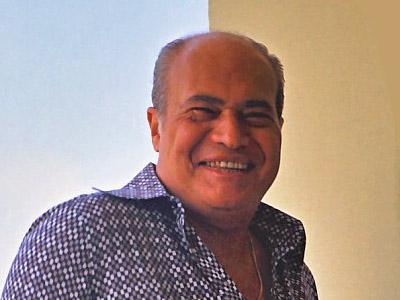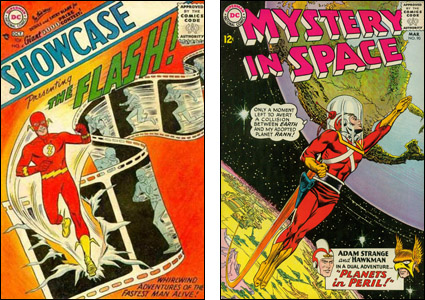
Carmine Infantino has died at the age of 87 and there is much to say…
In his day, Infantino was one of the great artists of comic books. Brooklyn born, he broke into comics while still in high school, mainly by assisting in the shop run by Harry Chesler. His initial ventures in actually creating pages were done in tandem with his boyhood friend, Frank Giacoia. At first, Giacoia drew the pages in pencil and Infantino inked, starting with the Jack Frost story in USA Comics #3 (Jan. 1942). Eventually, they switched roles and went their separate ways. Giacoia became one of the most respected inkers. Infantino became one of the top guys with a pencil. Carmine worked for DC, Timely, Hillman, Prize and other companies but from around 1955 on, almost all his work was done for DC and he became more and more important to the firm.
He drew dozens of features for the company but is probably best remembered as the artist who in 1956 designed and depicted the new, Barry Allen version of The Flash, launching a new wave of super-hero comics some would call The Silver Age. He also drew among many other strips, Adam Strange, Detective Chimp, Space Museum, The Elongated Man and in 1964 was the key artist for an update of Batman (the "New Look") which modernized the character for the sixties. He drew sleek, graceful figures and was topped by no one when it came to designing a panel that would convey movement. He was even better at designing covers.

In the sixties, he won most of the major awards for cover design and was able to parlay that into a job as DC's Art Director in charge of covers. At DC, the premise was that the cover sold the comic and it was not uncommon to design an exciting cover and then write the insides to go with it. By designing the covers, Infantino gained power and influence over the contents and before long, he was Art Director of the entire company. And he didn't stop there.
When DC was acquired by Kinney National Services (a corporation that eventually turned into Time-Warner), the old Editorial Director, Irwin Donenfeld, was ousted. Infantino was chosen to take his place and charged with the task of reinventing the entire line, which was then plagued by falling sales. During his first year in power, Infantino turned DC into a brand-new company, ousting many long-time staffers and freelancers and bringing in new ones, canceling old titles, starting new comics and totally revamping all the ongoing books. It is difficult to impress upon people how much DC changed in a short space of time.
Many wonderful comics and characters emerged: Bat Lash, Anthro, The Creeper, a whole new Wonder Woman, the acclaimed Green Lantern-Green Arrow series, Jack Kirby's Fourth World titles, the resurrection of Captain Marvel (Shazam!), a new series of Tarzan comics, Swamp Thing, The Phantom Stranger, Mike Grell's Warlord, Prez, etc. It's a very long list because, alas, most of these comics did not last long and were replaced by others — and then the others were replaced by others. Some comics were cancelled when the first sales figures trickled in; others, even before that. A few managed respectable runs but they were the exceptions.
Last weekend at WonderCon, I fell again into the ongoing debate that some of us have as to what went wrong during this period. My take, for what it's worth, is that as fine as Infantino was at designing covers and positioning creative folks to do good work, he lacked certain business skills that were essential to his job description. At the time, DC was plagued by an atrophying system of distribution and the management at Independent News — the sister company that disseminated DC's product to the masses — lost confidence in Infantino and to some extent in the whole idea of selling comic books. When your salesmen don't believe they can sell what you make, you probably can't. I believe DC was too swift to give up on some books that could have found an audience…but Infantino may not always have had much choice.
He was promoted to Publisher when the post came open but fired in January of 1976 and for years after, he searched for some sort of executive position. He never found one and eventually, he returned to drawing comic books. At first it was for Warren, then for Marvel — where he drew many comics but particularly soared (artistically and in sales) on their Star Wars comic. In 1981, he reluctantly began drawing for DC again — including a return to The Flash — though I don't believe he ever set foot in the DC offices after his dismissal as Publisher. Physical problems, mostly back trouble, eventually brought an end to his drawing days.
Infantino and I had a couple of unpleasant encounters over the years, as did some others who worked with him while he was running DC. I don't feel it's appropriate to go into them at length at this time. Maybe later, maybe not. I'll just say I admired his artwork and much of what he tried to do in an editorial capacity at DC, especially his first few years in that capacity. I thought that as Editorial Director and Publisher though, he was installed in a job at which no one could have succeeded and then he did some things, both creatively and in how he dealt with talent, that warranted serious criticism. Even then, he was a man of tremendous gifts and it was impossible to look at the last few decades of his life and not feel your heart break a little. When he was good, he was better than just about anybody.